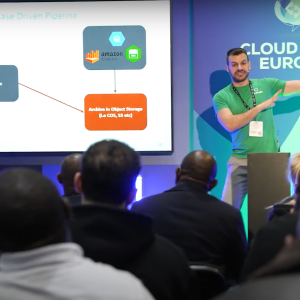
Analysts from research firm Gartner have outlined the Top 10 tech trends they expect to see in 2019. These strategic areas have “substantial disruptive potential” or are “rapidly growing trends with a high degree of volatility”.
Analysts presented their findings during Gartner Symposium/ITxpo, which is taking place in Orlando through Thursday.
The Top 10 Tech Trends 2019 According to Gartner
The company’s David Cearly, VP and Gartner Fellow, said: “[A] combinatorial effect of multiple trends [is] coalescing to produce new opportunities and drive new disruption.” Here are the top 10 tech trends his team selected.
Autonomous Things
Gartner expects “a shift from stand-alone intelligent things to a swarm of collaborative intelligent things, with multiple devices working together”.
These include robots, drones, and autonomous vehicles – all of which will use AI to more effectively and naturally interact with people and their surrounding environments.
Gartner also mentioned the delivery market, with autonomous vehicles and robots already being part of trials to transport food, parcels, and even medical services.
Augmented Analytics
Augmented analytics capabilities will advance rapidly to mainstream adoption, according to Gartner.
Automated insights will be embedded in enterprise applications — such as in HR, finance, sales, marketing, customer service, procurement, and asset management departments.
Not only will analytics be used increasingly in the workplace, but more people will be using and benefitting from them. Decisions will be taken not only by data scientists and analysts, but all employees – in other words citizen data science.
“Through 2020, the number of citizen data scientists will grow five times faster than the number of expert data scientists,” said David Clearley, vice president at Gartner.
“Organisations can use citizen data scientists to fill the data science and machine learning gap caused by the shortage and high cost of data scientists.”
Immersive Experiences
Immersive experiences will “change the way people perceive” the digital world. VR, AR, and MR will be thought of as “a multichannel and multimodal experience” – encompassing wearables, automobiles, and consumer appliances — as opposed to just individual devices such as headsets.
Immersive experiences will also start stimulating a greater range of both human senses – such as heat, humidity, and radar – as well as computer senses.
“This multi-experience environment will create an ambient experience in which the spaces that surround us define ‘the computer’ rather than the individual devices. In effect, the environment is the computer.”
Intriguing, slightly cryptic, and not sounding too unlike The Matrix.
Digital Twins
This is one we’ve been hearing of a lot recently. A digital twin is exactly as the name suggests: a digital copy of a real-life system or entity. Gartner believes that by 2020, there will be more than 20 billion connected sensors and endpoints and digital twins will potentially exist for around a billion things.
But beyond just the IoT, Gartner believes that organisations will begin implementing digital twins, evolving them over time until they can respond to business objectives.
Digital twins of organisations (DTOs) will help drive efficiencies in business processes, and create more “flexible, dynamic, and responsive processes” that can potentially react to changing conditions automatically.
In other words, a digital twin of your office could alert you of a leaking bathroom tap or a printer paper jam.
Blockchain
Gartner has some fairly strong words for the current state of blockchain concepts and technologies, calling them “immature”, “unproven”, and “poorly understood”.
It goes even further to say that many of the current blockchain initiatives do not implement all of the attributes of blockchain, calling them simply “blockchain-inspired” solutions.
Oragnisations who use these should understand their limitations and that some business outcomes may be achieved with better use of existing non-blockchain tech.
Basically, we’re all jumping on the blockchain bandwagon too soon.
However, CIOs and IT leaders should at least begin considering implementation of it, even if they don’t aggressively adopt the technology in the next few years, to help enable trust and transparency, reduce friction across ecosystems, and improve cash flow.
Smart Spaces
Whether you’re an employee, customer, community member, or general citizen, Gartner thinks an environment augmented with technology – either people, processes, services, or connected things – is going to start to become unavoidable.
Gartner didn’t provide any big predictions for the development of smart spaces, other than the market being at the early stages of accelerated adoption – in workplaces, cities, and factories.
But multiple elements of smart spaces will come together to form a more immersive, interactive, and automated environment, it added. 
AI-Driven Development
Data scientists are increasingly having to partner with application developers to create AI solutions that the developer can operate alone.
This will in turn provide the developer with an ecosystem of AI algorithms and development tools that can help them better integrate AI capabilities into their systems.
By 2020, at least 40 percent of new application development projects will have AI co-developers on their team, Gartner said.
Empowered Edge
Edge computing right now is largely being driven by IoT. Keeping processing close to the end user, as opposed to using a centralised cloud server, will reduce traffic and latency going forward.

But rather than create a new architecture, Gartner says cloud and edge computing will evolve as complementary models. Cloud services will be “managed as a centralised service executing, not only on centralised servers, but in distributed servers on-premises and on the edge devices themselves”.
Specialised AI chips, greater processing power, and storage will also lead to a wider array of edge devices over the next five years.
Gartner added, however, that the “extreme heterogeneity” of an” embedded IoT world” and the long life cycles of assets such as industrial systems will lead to management challenges.
Digital Ethics and Privacy
Following on from the enforcement of the revamped GDPR rules earlier this year, digital privacy rights will continue to be a growing concern as people think more about how their data is being used – and where it goes.

And the backlash will increase for organisations who fail to address such concerns, Gartner said. Ultimately, an organisation’s position on privacy is going to have to link pretty closely to its broader policy on ethics or trust.
“Shifting from privacy to ethics moves the conversation beyond ‘are we compliant’ toward ‘are we doing the right thing.”
Quantum Computing
Industries that have the most to gain from quantum computing are as follows: automotive, financial, insurance, pharmaceuticals, military, and research.
It may sound like an eclectic range of sectors, but in pharmaceuticals, for example, it could be used to model molecular interactions at atomic levels, which could speed up time-to-market for cancer-fighting drugs.
But will it be revolutionary in the next few years? Gartner warns: “Don’t believe the hype.”
“Most organisations should learn about and monitor QC through 2022 and perhaps exploit it from 2023 or 2025.”






